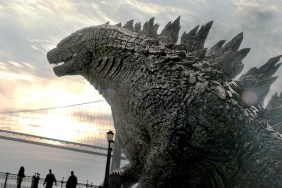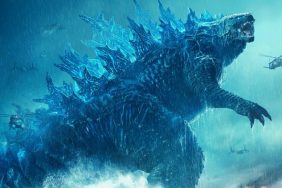I am now ten films into The Summer of Godzilla here on The Series Project (eleven, counting the American version of the original), and the films have finally started to teeter into iffy territory. Last week, you may recall, I was positively ecstatic about the Godzilla films I had seen to date, describing their frantic inner-child pleasures as indescribable and undeniable. I still feel that, when someone thought to dress two men in giant rubbery monster suits, and have them grapple violently atop a miniature Toho set while someone else films it, a magical cinematic event occurred. The very base pleasure of the Godzilla movies is still in place and, I feel, may never lose its charm.
But this week, the films will start to become spotty in their quality and cogency, which is saying a lot, seeing as we’ve been discussing a series of films that regularly features giant monsters, space aliens, ancient Venusian ghosts, laser-breathing dragons, and the discovery of Planet X. It’s not that the conceits of the movies have become too outlandish (is that even possible in the Godzilla universe?), but that the direction the series begins to face begins to feel trifling and even kind of disposable. I’m guessing that budgets began to drop, and the filmmakers began pandering to their younger audience a little bit too much. As such, we’ll soon be introduced to Godzilla’s son Minilla, who is effectively the Scrappy Doo of the Godzilla universe. Well, actually that mantle might belong to Godzooky, a minor monster from the 1978 Godzilla animated series. The point is that Godzilla was once playful and cool and monsterish. Now Godzilla movies are a hit-and-miss affair.
Indeed, the seventh film in the series (and the one we’ll be starting with this week) was once featured on an episode of “Mystery Science Theater 3000,” which is certainly no mark of its high quality. And the 10th film in the series (the one we’ll be closing with) commits one of the cardinal sins of sequel-making, and pads out its running time with endless clips from previous movies. Note to filmmakers: That never works under any circumstances. Don’t ever use footage from a previous films. There’s a reason no one eve talks about Puppet Master: The Legacy. Oh wait. Maybe the reason so few people talk about it because I’m one of maybe a dozen people who has even seen Puppet Master: The Legacy. I apologize for bringing it up.
So far, we’ve seen our leading monster fight King Kong, Anguirus, King Ghidorah, Rodan, and Mothra. Anguirus may be obscure, but I’m guessing casual monster fans have heard of the others. This week, we’ll kick off with a pretty forgettable monster in…
Godzilla Versus The Sea Monster
a.k.a Ebirah, Horror of the Deep


Release Date: 17th December, 1966
New Monster: Ebirah
Description: A giant squat ocean-bound lobster-like shellfish with giant pincers. It wasn’t a rock. It was a rock lobster.
Origin: Sea life mutated by local nuclear tests.
Destruction: Godzilla rips it apart and dips it in butter. I think it’s butter.
Actor(s): Godzilla, Haruo Nakajima. Ebirah, Yu Sekida
Ancillary Monsters: Mothra (in a cameo), and a giant red condor.
This is the first film in the series that was not directed by Ishiro Honda, and you can see the shift occur. Godzilla Versus the Sea Monster doesn’t have the same sort of joyous clunky bombast of the previous movies, and certainly has none of the storytelling ambition. Indeed, it seems as if Godzilla is making for a stab at a teen audience what with its sexy island babes and overwhelming use of surf music. Don’t get me wrong, I love surf music and – academically at least – the inclusion of surf music in a Godzilla film sounds like a fun idea. But it’s just mismatched and odd. What’s more, the film starts with a dance competition (!), and it doesn’t take you too long to feel the cognitive dissonance that come with the realization that a movie that will eventually feature a giant nuclear lizard wailing on a giant nuclear lobster begins with a dance-off.
The setup: A trio of naughty teenage boys (led by Toru Watanabe), and a bank thief who is hiding out from the cops (Godzilla regular Akira Takarada, always playing a different character) all hide out on a fancy boat for various reasons. The boat is fully stocked with provisions, as it was intended to make a trans-Pacific voyage. I’m not sure of small sailboats can actually make it all the way across the Pacific, but I’ve only been sailing a few times in my life. One of the teenage boys, Ryota, is looking for his brother who was recently lost at sea. They steal the boat and begin exploring. Even though the boat has months and months worth of food, our heroes, perhaps hypoglycemic, eat it all and begin worrying about provisions within the span of a few days. Luckily, they crash on a remote island and proceed to eat all the fruit there. With such hungry lead characters, and armed with the knowledge of an impending sea monster, I was kind of hoping that – in a bizarre plot twist – they would eat the villain of the piece. No such luck.
On this island, our hungry doltish heroes discover a secret government enclave called The Red Bamboo who have been covertly conducting nuclear tests. The Red Bamboo has also enslaved the indigenous population and forces them to grind up the local yellow fruit, and convert it into liquid. The yellow liquid (which is only ever referred to as The Yellow Liquid, which, yes, sounds a lot like a bathroom code) is used as Ebirah repellant. Ebirah is the giant sea monster who lives around the island. It’s a giant pink lobster crab thing that can crush ships in its pincers. It never ventures onto land.

Oh yes, and Mothra also hangs out on this island, complete with the miniature twin psychic fairy friends (played by pop duo Pair Bambi). Mothra – now a fully-formed moth again – lives a sweet life on tropical islands being worshiped by the locals. Good work if you can get it. Mothra, however, plays a small role in the film, and she was included merely for cameo purposes. She will eventually fly our heroes to safety after the film’s climax. Oh yes, and that one guy’s brother actually is on this island, living with the natives and worshiping Mothra.
And, of course, Godzilla is here too, once again hibernating, this time in a cave. As is the pattern with these movies, Godzilla doesn’t show up until about 30 minutes in. When our heroes learn of the nuclear malfeasance and slave-driving nature of The Red Bamboo (couldn’t they have come up with a batter name?), they attach a wire to a lightning rod/sword, and run an electrical wire down into Godzilla’s cave. It take s a few days, but eventually a storm brews, lighting strikes, and Godzilla emerges to stomp around on The Red Bamboo’s buildings, smash all their nuclear stuff, free the slaves, and wade into the ocean to do epic monster battle with Ebirah. Something I have learned from Godzilla movies: If you put two monsters next to each other, they gonna do fight.

The fights between Godzilla and Ebirah are goofier than usual (and these movies are plenty goofy). Godzilla throws a rock, Ebirah bats it back with its claw, Godzilla punches it, etc. The two monsters don’t so much fight as play a high-octane monster version of tennis. Although Ebirah will get ambitious and try to pinch Godzilla, forcing Godzilla to rip off its claws one by one, and leave it to bleed to death surrounded by The Yellow Liquid. An undignified end to an undignified monster.
Godzilla Versus the Sea Monster feels so trifling after the extraterrestrial shenanigans of the previous few movies. The tone is light and comic and downright silly, and the new director seems to be openly acknowledging Godzilla’s more ridiculous aspect. It’s a dance competition in the middle of a battlefield. A bikini babe at the threshold of the apocalypse. It’s a little weird.
And it will only get more weird and even more obnoxious, as we’ll have Minilla’s long-awaited first appearance in…







